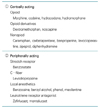Use of Antitussive, Mucolytic Agents and Expectorants
Article information
Abstract
Cough associated with acute or chronic respiratory conditions is common in patients of all ages. Current antitussive agents are classified broadly according to their site of action as either central or peripheral, although many antitussives act in both ways to some extent. Identification of the underlying condition is critical to successful treatment of cough. However, when the etiology of cough is not identified, or when the cough persists despite treatment of the condition, nonspecific antitussive therapy is indicated. Mucus hypersecretion is a cardinal sign of both acute and chronic pulmonary diseases. Normally, mucus protects the respiratory tract, but its overproduction leads to airway obstruction and promotes bacterial colonization. Mucolytic agents are classified into several groups according to their pharmaceutical characteristics. Mucolytics such as Ambroxol and N-acetylcysteine can alter the secretion and physical properties of mucus, resulting in the improvement of mucociliary clearance. There are still debates whether mucolytics can improve lung functions and patients' quality of life. In subjects with chronic bronchitis or COPD, treatment with mucolytics was associated with a small reduction in acute exacerbations and a somewhat greater reduction in the total number of days of disability. Undoubtedly they are useful as an adjunctive treatment of respiratory tract disorders.

